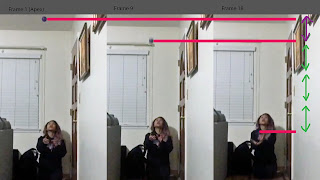
In truth, the thought of defying
gravity—of battling the impossible—has captivated the world since the beginning
of time. Stories of dragons, monsters, and supernatural warriors fill the pages
and screens of the world’s literature and media. As a whole, society loves
nothing more than seeing people beat the odds; they root for the hero. They
want to see the hero battle the impossible—to see them defy gravity. In fact,
that is the very reason video games, comic books, and comic book adaptations
are so popular during times of hardship. They bend the laws of physics in ways
that engage and entertain the audience. One specific comic book adaptation, director
Edgar Wright’s 2010 film “Scott Pilgrim vs. The World,” excels in particular. “Scott
Pilgrim” is about Scott, a 23-year-old bassist who must battle his girlfriend
Ramona’s seven evil super-powered exes in order to win her heart. In “Scott
Pilgrim,” Wright breaks the laws of physics in our own world in order to create
a humorous yet epic movie that pays homage to video games and comic books
around the world with its use of supernatural energy, exaggerated paths of
action, and strange inertia.
Firstly, “Scott Pilgrim” uses supernatural energy to enhance the events and struggles that occur throughout its entirety, which particularly manifests itself through the superpowers. For example, when Scott fights Ramona’s first evil ex-boyfriend Matthew Patel, Matthew generates and shoots fireballs at Scott. Obviously, humans naturally cannot naturally generate fire from thin air. In that particular way, “Scott Pilgrim” breaks the laws of physics. Another example of supernatural powers manifesting themselves is in Ramona’s third evil ex Todd Ingram, who possesses telekinetic vegan powers. One such specific power is Todd’s ability to fly—or rather, levitate. In fact, twice during Scott’s bass battle with Todd, Todd levitates toward Scott. By floating, Todd breaks the law of gravity. Furthermore, another example of superhuman power are the giant energy monsters that appear to fight each other during Scott’s battle with the Katayanagi twins, Ramona’s fifth and sixth evil exes. Specifically, as Scott’s band Sex Bob-omb and the Katayanagi twins battle each other in Battle of the Bands, their music generates energy monsters—Sex Bob-omb summoning a giant yeti and the Katayanagis summoning twin snow dragons. In the end, after a several back-and-forth-blows, Sex Bob-omb’s yeti wins. In this case, summoning giant energy monsters is highly improbable; the physics is completely ignored. However, all considering, the way in which Wright breaks the laws of physics only serve to enhance the heroism and comic-book feel of “Scott Pilgrim.”



In addition, to create the
larger-than-life comic-book hero feel of “Scott Pilgrim,” the movie used
exaggerated paths of action and a lack of gravity in several of Scott’s fights
with the evil exes. For example, in Scott’s fight with Matthew Patel, Scott
sends Matthew into the air with an uppercut kick, jumps high and uppercuts
Matthew again, barrages him with a flurry of punches, and lands a final punch
that sends Matthew hurtling to the earth as Scott floats and watches from
above. According to the law of gravity, Scott should have to the earth rather
than floating above Matthew. However, by Scott floating as Matthew flies toward
the earth, Scott holds the position of power in the fight. Therefore, by
breaking the law, the story of Scott’s success during his fight with Matthew
Patel is enhanced. Another example of exaggerated paths of action is in Scott
and Ramona’s second evil ex-boyfriend Lucas Lee’s fight. During the fight,
Scott and Lucas charge at each other and jump into the air, at which point they
meet and Lucas kicks Scott backwards through a backdrop. According to the laws
of physics, their jumps should neither have had the trajectory nor the power to
send Scott flying through the air. In that case, to dramatize the battle and
accentuate the comic-book feel of the movie, Wright breaks the laws of physics.
To further the examination of exaggerated paths of action, one must also
consider Ramona’s fight with Roxy, her fourth evil ex. During the fight, Ramona
dodges a hit from Roxy by flipping backwards high into the air with her giant
hammer. Truthfully, Ramona’s jump looked far too weak to be able to manage such
a high jump while toting a heavy weapon. In such a case, Ramona’s jump breaks
the law of gravity, like in the other fights, just enough to enhance the
comic-book feeling without being overtly ridiculous.


Additionally, in “Scott Pilgrim,” the
movie uses strange inertia during the battles to truly push the comic-book
superhero vibe. For example, when Scott faces Matthew Patel, Scott blocks
Matthew—who was in the middle of a 100 mph flying punch—stops him midair,
punches him backward, and sends him tumbling through the air. However, even
when bending the laws of physics, there is still a realistic sense of inertia
and gravity when Matthew lands on his feet. Specifically, Matthew’s motion is
stopped by the ground, an equal and opposing force. In turn, “Scott Pilgrim”
twists the laws of physics but still manages to provide a tangible sense of
existence, ultimately making the “Scott Pilgrim” world believable. Also, when
Scott battles Todd, the power from Todd’s bass sends Scott flying through
several walls without slowing him down until Scott reaches the last wall. In
the real world, the power of Todd’s bass would not have been enough to push
Scott through three walls, but also Scott would have slowed down a significant
amount after hitting the first wall. Instead, Scott kept going. In such a case,
Wright dramatizes the attack and pushes the comic-book vibe, effectively
enhancing the story and action in “Scott Pilgrim.” Furthermore, in the fight
between Ramona and Roxy, Ramona blocks Roxy from kicking Scott midair and each
girl holds their pose for three seconds in real time—much like Scott did in his
fight with Matthew. In reality, Ramona would have blocked Roxy, who then would
have proceeded to drop to the ground due to the law of gravity. However, in
having the girls hold their pose, Wright enhanced the superhero, comic-book
feel of the movie by emphasizing that key moment of the fight when it begins. All
in all, Wright effectively uses strange inertia to form a cartoon-y yet
tangible world in which the characters of “Scott Pilgrim” live, enhancing the story
and making it entertaining to audiences.



In “Scott Pilgrim vs. the World,” Edgar
Wright bends the laws of physics to create an entertaining yet realistic world
for the audience’s beloved super-powered comic book heroes and villains. Notably,
Wright uses supernatural energy to empower the characters. Also, Wright makes use
of exaggerated paths of action and a lack of gravity in order to push the
comic-book feel of the movie, which sets the tone for the film. In addition,
Wright utilizes strange inertia to not only amuse and excite audiences but also
to help shape a world in which superheroes make sense to exist in. By
intentionally breaking the laws of physics in the “Pilgrim” world, Edgar Wright
enhances the comic-book and video-game feel of the movie to make it more
entertaining to audiences and stay true to the comic.






















